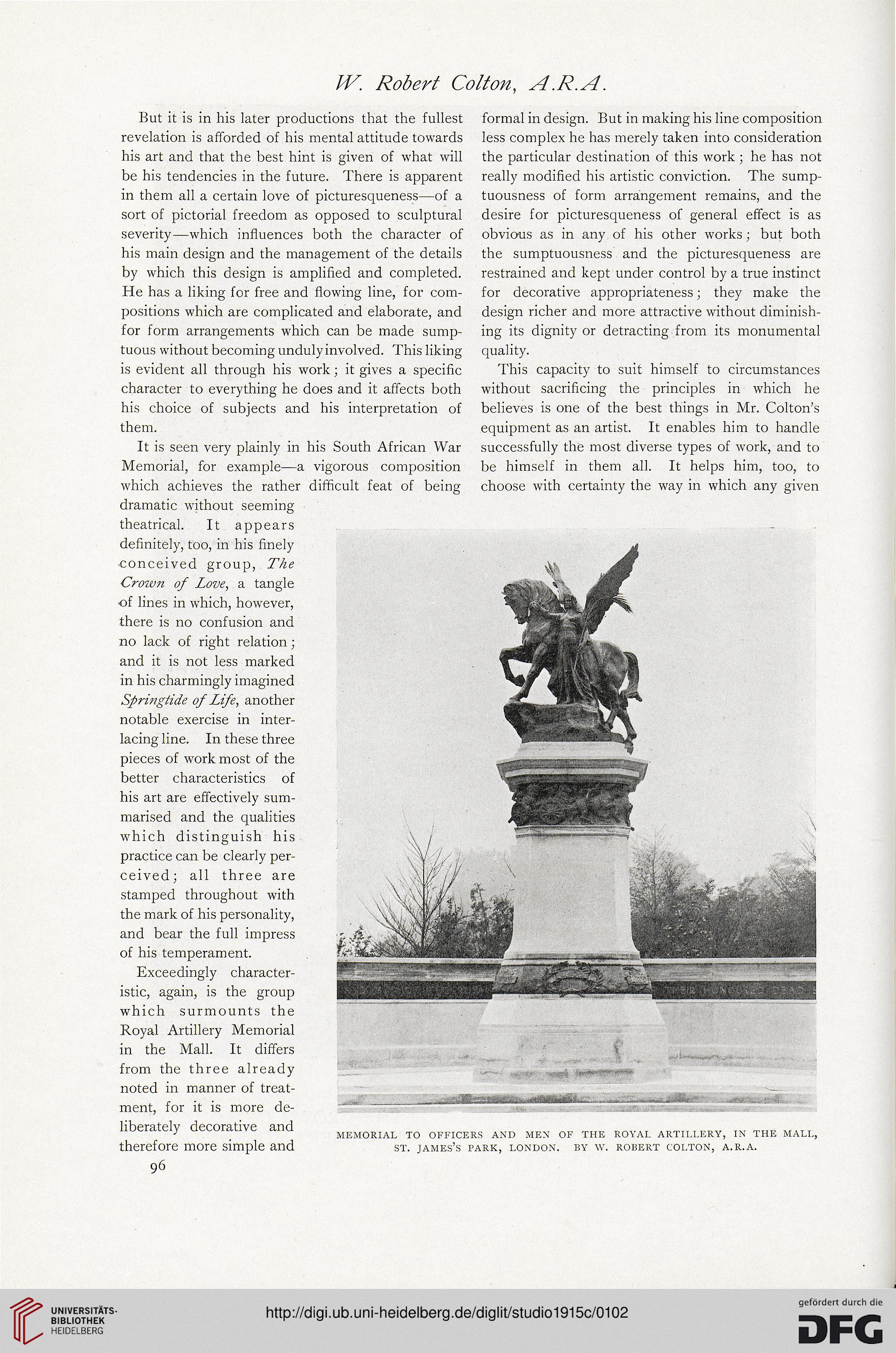IV. Robert Colton, A.R.A.
But it is in his later productions that the fullest
revelation is afforded of his mental attitude towards
his art and that the best hint is given of what will
be his tendencies in the future. There is apparent
in them all a certain love of picturesqueness—of a
sort of pictorial freedom as opposed to sculptural
severity—which influences both the character of
his main design and the management of the details
by which this design is amplified and completed.
He has a liking for free and flowing line, for com-
positions which are complicated and elaborate, and
for form arrangements which can be made sump-
tuous without becoming undulyinvolved. This liking
is evident all through his work; it gives a specific
character to everything he does and it affects both
his choice of subjects and his interpretation of
them.
It is seen very plainly in his South African War
Memorial, for example—a vigorous composition
which achieves the rather difficult feat of being
dramatic without seeming
theatrical. It appears
definitely, too, in his finely
conceived group, The
Crown of Love, a tangle
of lines in which, however,
there is no confusion and
no lack of right relation;
and it is not less marked
in his charmingly imagined
Springtide of Life, another
notable exercise in inter-
lacing line. In these three
pieces of work most of the
better characteristics of
his art are effectively sum-
marised and the qualities
which distinguish his
practice can be clearly per-
ceived; all three are
stamped throughout with
the mark of his personality,
and bear the full impress
of his temperament.
Exceedingly character-
istic, again, is the group
which surmounts the
Royal Artillery Memorial
in the Mall. It differs
from the three already
noted in manner of treat-
ment, for it is more de-
liberately decorative and
therefore more simple and
formal in design. But in making his line composition
less complex he has merely taken into consideration
the particular destination of this work; he has not
really modified his artistic conviction. The sump-
tuousness of form arrangement remains, and the
desire for picturesqueness of general effect is as
obvious as in any of his other works; but both
the sumptuousness and the picturesqueness are
restrained and kept under control by a true instinct
for decorative appropriateness; they make the
design richer and more attractive without diminish-
ing its dignity or detracting from its monumental
quality.
This capacity to suit himself to circumstances
without sacrificing the principles in which he
believes is one of the best things in Mr. Colton’s
equipment as an artist. It enables him to handle
successfully the most diverse types of work, and to
be himself in them all. It helps him, too, to
choose with certainty the way in which any given
MEMORIAL TO OFFICERS AND MEN OF THE ROYAL ARTILLERY, IN THE MALL,
st. james’s park, London, by w. Robert colton, a.r.a.
But it is in his later productions that the fullest
revelation is afforded of his mental attitude towards
his art and that the best hint is given of what will
be his tendencies in the future. There is apparent
in them all a certain love of picturesqueness—of a
sort of pictorial freedom as opposed to sculptural
severity—which influences both the character of
his main design and the management of the details
by which this design is amplified and completed.
He has a liking for free and flowing line, for com-
positions which are complicated and elaborate, and
for form arrangements which can be made sump-
tuous without becoming undulyinvolved. This liking
is evident all through his work; it gives a specific
character to everything he does and it affects both
his choice of subjects and his interpretation of
them.
It is seen very plainly in his South African War
Memorial, for example—a vigorous composition
which achieves the rather difficult feat of being
dramatic without seeming
theatrical. It appears
definitely, too, in his finely
conceived group, The
Crown of Love, a tangle
of lines in which, however,
there is no confusion and
no lack of right relation;
and it is not less marked
in his charmingly imagined
Springtide of Life, another
notable exercise in inter-
lacing line. In these three
pieces of work most of the
better characteristics of
his art are effectively sum-
marised and the qualities
which distinguish his
practice can be clearly per-
ceived; all three are
stamped throughout with
the mark of his personality,
and bear the full impress
of his temperament.
Exceedingly character-
istic, again, is the group
which surmounts the
Royal Artillery Memorial
in the Mall. It differs
from the three already
noted in manner of treat-
ment, for it is more de-
liberately decorative and
therefore more simple and
formal in design. But in making his line composition
less complex he has merely taken into consideration
the particular destination of this work; he has not
really modified his artistic conviction. The sump-
tuousness of form arrangement remains, and the
desire for picturesqueness of general effect is as
obvious as in any of his other works; but both
the sumptuousness and the picturesqueness are
restrained and kept under control by a true instinct
for decorative appropriateness; they make the
design richer and more attractive without diminish-
ing its dignity or detracting from its monumental
quality.
This capacity to suit himself to circumstances
without sacrificing the principles in which he
believes is one of the best things in Mr. Colton’s
equipment as an artist. It enables him to handle
successfully the most diverse types of work, and to
be himself in them all. It helps him, too, to
choose with certainty the way in which any given
MEMORIAL TO OFFICERS AND MEN OF THE ROYAL ARTILLERY, IN THE MALL,
st. james’s park, London, by w. Robert colton, a.r.a.




